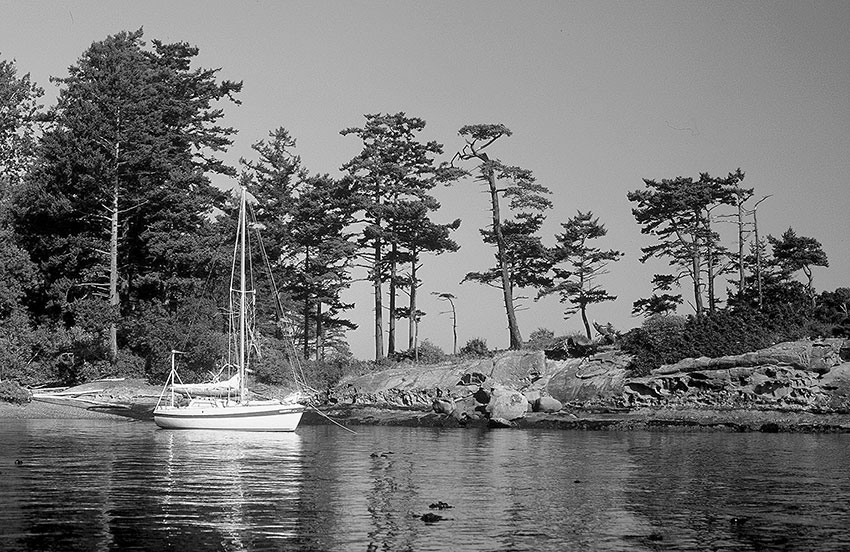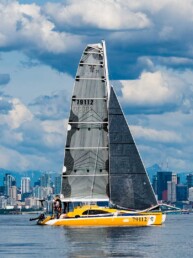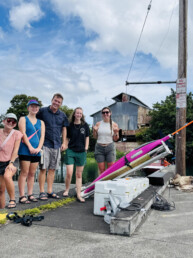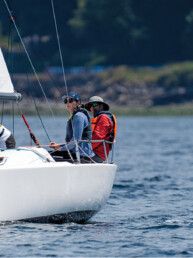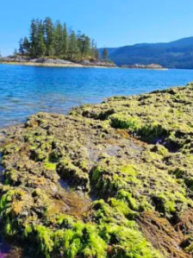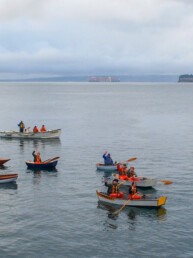In our latest Throwback Thursday, we’re kicking it back to a near miss story in the October 2003 issue of 48° North by Lance Ekhart.
It all started innocently enough. I am careful to always shorten my dinghy painter before making any maneuvers with the engine and I did so this time, but obviously not enough. In preparing to raise the anchor the outboard grabbed the errant line and stopped. How embarrassing! I instinctively looked around to see if anyone noticed and I found no one pointing and laughing. Well no biggie, I thought as I lifted the engine out of the well and cleared the wrap figuring that was the end of it. Little did I know this was the start of quite an adventure in my Columbia 26 mkII, Shariyat.
 Sailing out of Cabbage Island Marine Park in the southeast corner of the Gulf Islands in very little wind was not on my agenda that morning even though I like to sail off the hook whenever possible. But I would have no choice as the engine was now stuck in reverse even though I took it apart as far as I dared to try to free it. Somehow the force of wrapping the prop caused a serious internal problem. Fortunately enough wind had come up to tack out the narrow channel and make it out over the long reefs guarding the anchorage. Turning south towards Lummi Island I raised the chute and was very glad I had the big light sail as the wind died to almost nothing and for two hours I ghosted along at less than 1.5 knots, sometimes just barely keeping steerageway. I intently concentrated on not losing momentum as I knew I might never gain it back in those conditions, but I couldn’t help thinking about what I would do if the wind quit altogether, something quite common in the summer months in the islands.
Sailing out of Cabbage Island Marine Park in the southeast corner of the Gulf Islands in very little wind was not on my agenda that morning even though I like to sail off the hook whenever possible. But I would have no choice as the engine was now stuck in reverse even though I took it apart as far as I dared to try to free it. Somehow the force of wrapping the prop caused a serious internal problem. Fortunately enough wind had come up to tack out the narrow channel and make it out over the long reefs guarding the anchorage. Turning south towards Lummi Island I raised the chute and was very glad I had the big light sail as the wind died to almost nothing and for two hours I ghosted along at less than 1.5 knots, sometimes just barely keeping steerageway. I intently concentrated on not losing momentum as I knew I might never gain it back in those conditions, but I couldn’t help thinking about what I would do if the wind quit altogether, something quite common in the summer months in the islands.
With the delay involved in the engine problem I got a late start on catching the southbound ebb current and it would soon turn against me easily overpowering the light breeze. To make matters worse the favorable northerly wind then shifted almost 180 degrees to put it right on the nose for heading down Hale Passage so I dropped the chute and raised the big genoa.
What were my options? Well, I had reverse even though it is terribly inefficient and can only provide at best 2 knots. How long could I stand steering in reverse? I had to do this before in Alaska with another boat and found that the force on the rudder was too great to continue for long. But could the autopilot be made to work? Could I turn the pilot compass upside-down and have it work in reverse? Whether or not that might actually work, I was seeing very clearly how necessity is indeed the mother of invention!
Perhaps being more practical, I looked for somewhere to anchor if necessary, to prevent being sent back to Canada on the coming flood tide. I was crossing over extensive Alden Bank with its 20 to 30 foot depths and figured I could at least drop the hook there. But I could see being there until the next day’s afternoon breeze.
I chastised myself for taking my strobe light off the boat. I could send that up the mast and feel OK enough to go below and catch some sleep that night. Then I realized the importance of that seemingly stupid black ball you’re supposed to hang in the rigging as a day-shape indicating that you are anchored. You might not need it often but here would be one of those times. Since I was singlehanding, as usual, I would eventually need to sleep with no-one on watch.
With all the what-ifs going through my mind I realized I was allowing myself to worry and become impatient. This was really no big deal after all and I consider myself in training to take off and do serious long-distance voyaging again. Is this any different than crossing the equator and its doldrums? Am I going to fret about how long I will be becalmed then? Why don’t I treat this like being on a long sea-voyage? So what would I be doing in that case?
I suddenly had the urge to listen to old blues and rock-n-roll tunes, so I cranked up the stereo to some old John Mayal and soon I was dancing in the cockpit having a good time! (Those who have seen me dance would say it’s a good thing I dance alone anyway!) I couldn’t help but drum along with the music’s strong beat and since I didn’t have a drum on board I started a quest to find which part of the boat had the best tone. After much experimentation I determined that the sides and floor of the cockpit had the best bass but that the best overall sound came from the sliding companionway hatch.
Well I soon didn’t care how long I was out there and was thinking about doing some easy odd jobs I’d been putting off like whipping line-ends when the wind picked up. Well it really came on and soon I was down to a reefed main and working jib and I was thinking about the storm jib as a huge tropical looking cloud was building to the south. The wind slowly veered allowing me to almost point up to the desired course and no current that day was going to match the 6 knots I was now making towards home. I made it into Squalicum Harbor before dark, sailed into the visitor’s dock and planned to take the outboard in for repair the next morning. What I didn’t know then was that the adventure had hardly begun.
Fixing the outboard in Bellingham was a drawn out fiasco that I won’t go into except to say that after leaving I had to return partly because the outboard now wouldn’t go into reverse. The mechanics warned me that the fix may not last without tearing most of the engine apart to fix it properly, something not worth doing to my 1974 model. I hoped they were just trying to save face for having put it back together wrong. Ha, Ha!
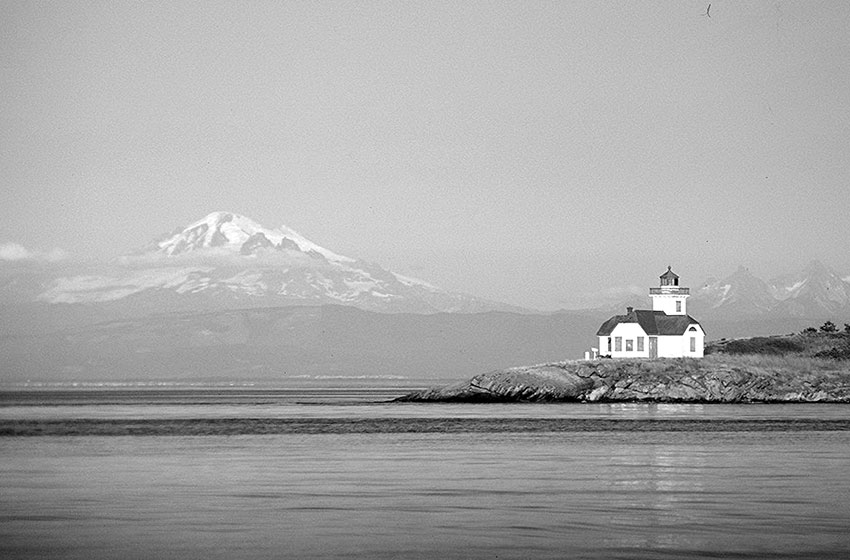
Now it was time to head back to Sidney, BC and I planned to do it via Sucia Island to take in the Perseid meteor shower that night. I felt good that the outboard was working and the boat was fast after cleaning the heavy slime off the bottom. I sailed about 2/3 of the way as the good breeze alternated with calms. Being mid-week I decided to continue to Patos Island and see if I might get lucky and find an available bouy in pretty but small Active Cove. On the way I passed by the cove at Toe Point to check it out and found it empty. Active Cove was full with four boats so I continued around the island avoiding the reef at the SE tip and anchored bow and stern back at Toe happy with it all.
My reverie ended though when I went to set the anchor in reverse and couldn’t get it back out of gear just like before! It’s amazing to me how quickly my mood can shift as the what-ifs again played in my mind like dominoes cascading my future into some unknown disaster. I quickly caught myself and started trying to appreciate the certain adventure that lay ahead. The full moon on that calm and clear night was beautiful but it washed out the meteor shower and I wasn’t in the best mood to enjoy it anyway.
In thinking about my new situation it was clear that the weather and currents would drive my plans and actions. The bad news was the forecast was for light and variable winds which meant I would have to ride the currents as much as possible. The full moon meant the tides would be extreme so I would have about a six hour window during the day to travel SE towards Sidney. The current atlas showed those times to be in the morning which was also bad news as the winds would generally be stronger in the afternoon. So what did I have going for me? The boat was clean and fast, I had a 14’ sweep to row it if necessary and I already had the experience of towing the boat with the dinghy- a technique more efficient than using the sweep.
The next day didn’t start well. The favorable current started at 8AM but there wasn’t any wind so I held off leaving, hoping for some wind to arise. I soon realized my error when looking out at Toe point I saw the strong tide rips over the reef at the cove’s south point. I recalled the notes in the current atlas saying to beware the strong rips in the vicinity of Patos Island. I admit to indulging in Patrick O’Brian novels and I realized I was in a similar predicament to an old sailing vessel trying to beat out of a small bay in a storm. Was I effectively “embayed”, unable to get out?
I took the dinghy and did a trial run of exactly how I might tow Shariyat out. I hugged the north shore but as soon as I cleared the north point of the bay I was shocked how quickly the current swept me toward the reef on the other side. I rowed slowly to mimic the speed I thought I would be able to make towing Shariyat and I did clear the reef but not by much. I allowed myself to be swept around the corner although I didn’t really have a choice as the flow was much faster than I could row. I was confident I’d find a back-eddy on the other side near shore and I was right.
I was safe but not at all sure I could get back to Shariyat. I had visions of spending the next 4 hours on the other side of the island before the current slacked and then not having another chance to leave the anchorage until the next day. I tried about six times to get over the reef, each time in shallower water, until I found I could make it where it was only six inches deep. Trying to row hard and fast in so little water was hell on my oar blades though as they kept striking the rocks. But I was back in the cove and quickly made my preparations for what was to be either success or disaster.
Everything had to go correctly. I had to be in the dinghy rowing as soon as the anchor was up to get to the north shore to proceed out. The wind was threatening to come up but was not favorable, so I had to be ready to raise sail immediately if necessary. I took a few deep breaths, thanked the current gods for my impending success and raised the anchor. I got the boat along the favorable shore nicely and pulled like mad to get up momentum before encountering the cross-current once out of the bay. Again I was shocked at the speed I was making toward the reef once I was grabbed by the current but all I could think was “pull harder, pull faster.” I wasn’t sure we were going to make it but I never saw the reef under me in the clear water. I was clear!
I didn’t have any time to rest however as the swift current was taking me towards more reefs on Sucia, not far away. There was definitely a breeze though so I was soon sailing. I cleared Sucia and was heading for Waldron Island and I had to decide which way around to go. North over the top would certainly be best but soon that became impossible. I was making 3 knots and 5 over the bottom though so I wasn’t complaining. I set the chute to take the southerly route and soon at 3 knots boatspeed I was making 7 towards home. I realized there was no way to fight this current if the wind died. Because of the late departure from Patos I would never make it through Speiden Channel in time so I planned to make Stuart Island and anchor somewhere there for the night.
The wind slackened about the same time as the current and before long, although pushed right towards Stuart, I was at a half- knot of boat speed and only 1 knot over the bottom. Would I make it in time? I had my spot picked out, the outer bay at the south end of Prevost Harbor. I was close-in to the island now but had to get north about a half-mile. The tables said the current was slack so I figured I had no choice but to get back in the dinghy and row. I could see I was making progress and got to within a quarter-mile when the wind picked up a bit so I quickly got back to Shariyat and raised sail only to have the wind die again. So again it was drop sails, get back in the dinghy and row. The wind came up again and so back aboard and sailing at 1 knot I went. I was within 100 yards when I conceded the game as it appeared a current was coming out of Prevost through the south entrance thwarting my efforts. I had spent almost two hours making that last 1.5 miles. I could smell victory but it was not mine!
So now what were my options? The new flood current, although generally northerly, would apparently flow south along the NW side of Stuart Island. If I could stay close-in I could ride it to another spot to anchor but if not I would be sent north to Canada and who-knows-where in the Gulf Islands. I made steady progress drifting and ghosting towards John’s Pass between Stuart and Johns Island. The atlas wasn’t clear which way the current would flow there, but I soon saw strong rips flowing out towards me. The tack I was on would just clear the north entrance point and in spite of the rips close by I was getting pulled into the pass. The wind picked up a bit and I was making good 2 knots into the pass and there was an anchorage in the middle of it on my side.
Could I ride a counter-current through to it? With the shore a few feet away to starboard and the rips sweeping out just a few feet to port I continued to make good 1.5 knots. But it was too good to be true. I guess the rips finally saw my attempt to fool them and came over and grabbed me sending, me back out the pass at 3+ knots. I knew I couldn’t allow it to take me far from the island or I would lose the favorable current close alongshore so I sailed for the opposite side of the pass. There I got stuck in an eddy and went round and round a few times just clearing a shoal lurking nearby. The pass must have had mercy on me as it finally let go, but I had succeeded in staying close to the island so I still had another chance.
I continued to drift as now there wasn’t a drop of wind but I was making a half-knot towards my next potential anchorage, a little cove a half-mile away. My progress stalled however and looking away from the island I could see ribbons of opposite-flowing currents near me just 20 to 30 feet wide. I was now in the wrong ribbon! I waited a few minutes to see if a favorable one would come rescue me but I continued to head back towards that unfriendly pass. I then set up my big sweep and rowed into the next ribbon and I was on my way again. Twice more I had to re-position myself in the correct flow as I inched my way towards the last possible refuge for the evening.
My haven was now in view so once again I manned the dinghy and leisurely rowed Shariyat around the point and into the bay, lined up for dropping the anchor. With no wind or current it was a piece of cake! I had to quickly get back aboard and drop the hook before fouling some mooring bouys. It had been almost for hours now since I had first approached Stuart/Johns Islands, and six hours to go nne miles, but at least I could sleep soundly that night and I sure needed it!
As I was clearing the deck a young man came out in his dinghy from one of the many houses in the cove and asked if I was OK. I guess I made a strange sight coming in. He generously offered one of the moorings if I wanted it, but I said “No thanks.” He asked why I came in that way, so I told him the whole story. He got an incredulous look on his face like I was from some other time or planet and I’m not sure he believed me at first. He then felt sorry for me I guess because he then offered his house if I needed anything. I told him I had everything I needed but thanked him anyway.
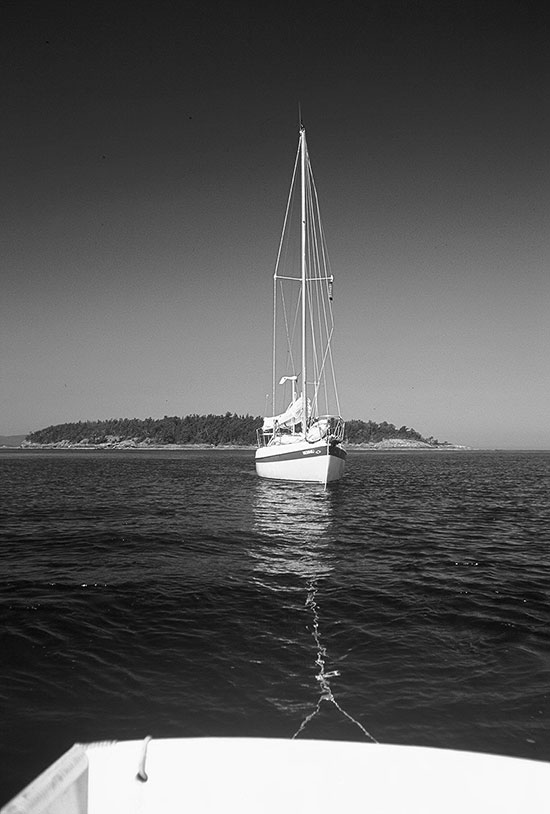
As he motored away he kept looking back as if he expected me to disappear like some apparition. It made me wonder if any young people today really understand what it was like before engines (not that I’m old enough to remember it!). That got me thinking about how many times I too had wondered how the early explorers here had made their way around these waters with the heavy and unweatherly vessels they had at their disposal. I guess what I went through that day would just be a normal thing for them, but today it’s considered an ordeal. I think we’ve come a long way from being self-reliant. Or maybe with our fast-paced lives we’ve become too impatient. I could feel that my perspective had shifted a bit as I really was seeing this trip more as an adventure than a hardship. I slept well and dreamt of wind!
Not making it to my first planned anchorage created a challenge for the next day. The morning’s favorable current on my side of John’s Pass would sweep south and then across a series of reefs on the south end of Johns Island. Similarly, if I dared Johns Pass, its south entrance was equally foul and without wind the currents would be treacherous there too. On the north side of the pass the current would flow north and around the clear and safe Turn Point Light. But I had to get past Johns Pass against the local current flow to get there. In addition, if I started by heading south from where I was then I would be swept south down Haro Strait and well past my more westerly destination, Sidney, if there was no wind. I figured all I could do was row out early, hope for the best, see what happens and deal with whatever I get.
I was all ready to raise the hook and get into the dinghy when the wind came up blowing out of the cove. I quickly raised sail and in ten minutes I covered more ground than in two hours the day before! I could see the glassy water of no wind ahead and I hoped I could at least make it past the pass where the current split and became favorable again. It felt like I had just received a gift of the gods as the wind died away just after crossing the mouth of the pass.
I was doing everything I felt I could possibly do and wondered if just maybe something beyond my puny efforts appreciated that! I was now at the mercy of the currents again and heading towards Turn Point at about 1 knot and increasing. The wind lightly came and went but the current eventually shot me into Haro Strait at 3+ knots. Fortunately there was no ship traffic around the point as all I would be able to do would be to get on the radio and announce myself as a hazard to navigation. The converging currents at Turn Point really churned up a confused sea and even though there was a bit of wind I was dead in the water until I drifted clear.
Now this day’s fun would start. I had to get north over the top of Gooch and Brethour Islands, but Haro Strait had other plans in its relentless march south. The wind picked up and then almost died as it came aft. The only chance was with the spinnaker. Hoisted, I tried to get north of Arachne Reef but the wind died again and I had to let the current take me well south of it. This was not good. The wind then came around forcing me to gibe right when a parade of four Bayliners stormed right by me. I survived them and the gibe only to have the wind die and come ahead again, so I had to quickly drop the chute.
Within three minutes the wind came aft again so I scrambled to get it repacked and reset. What a tangled mess! I got it up and drawing just in time to barely get north over Joan Rock. It was amazing how I would have to steer 90 degrees from my intended course in order to counter the current as I got a reminder of my high school vector-physics. I think the wind gods were now humoring me as the wind soon backed again forcing me to drop the chute within minutes of putting it up, once more. Just to be prepared I quickly repacked it and prepared to reset it a third time when the wind picked up and for the first time in two days could see good wind on the water all around me. It now looked like I may actually get to Sidney that day!
I passed Coal Island at 7+ knots and ran into a big wind hole in it’s lee. So it was not over yet. Although I had a half-knot of current behind me I was doing 360’s now and in the process wrapped the dinghy painter around the rudder jamming between it and the hull. Very quickly the rudder was getting harder to turn and I was chagrined as I realized that the same culprit that caused this whole mess in the beginning was now trying to prevent its ending as the current now started moving me away from Sidney just one mile away! I dropped the sails and quickly got into the dinghy once again, was able to free the rudder and took Shariyat in tow. As soon as I got momentum up the wind returned so I rushed back to the boat and raised sail. But it just as quickly died again so I was back to rowing. I knew I was definitely going to make the harbor entrance now as the wind came up again and into the harbor I sailed. I found a spot to anchor and dropped the hook at 3 knots downwind. I was nearly thrown off the deck when the anchor bit and wrenched the boat around but I knew it had set! Wow! I almost couldn’t believe I had finally made it.
I found that instead of feeling upset about the whole trip I was wearing a big grin and realized I wouldn’t trade the experience for anything. I had a huge sense of accomplishment and in the required intimacy with the elements I had learned a lot more about the tides and currents in the islands as well as what was possible to achieve using them (and avoiding them). But I am planning to fix the motor!
48°N

